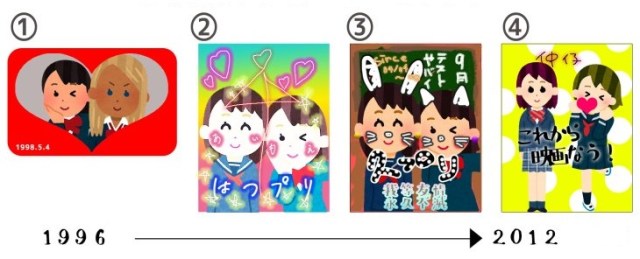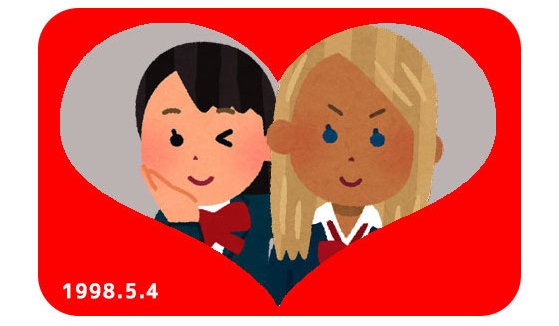
Taking a look back at four eras of the Print Club past.
Purikura (a contracted version of “Print Club”) sticker photos have been part of fashionable teens’ lifestyles in Japan since the mid ‘90s. Individual fashions have changed a lot over the past two-and-a-half decades, though, and in recent years simple purikura without a lot of added accoutrements have been in style.
However, there’s growing interest among today’s Japanese high school girls for the extravagant after-effects of stamps and squiggles that were popular in the earlier days, suggesting that we’re on the cusp of a comeback for the “Heisei purikura” style, Heisei being the Japanese Imperial calendar era that ran from 1989 to 2019. But with Print Club machines first appearing in 1995, there’s 24 years’ worth of Heisei purikura trends, so let’s take a look back at the subsets of purikura history with the help of four of our Japanese-language reporters who experienced them first-hand.
1. Original Heisei purikura era
(as remembered by Mariko Ohanabatake, now 38 years old)
“Purikura were still very new, and the most important thing was choosing a good digital frame/border. We spent a lot of time looking for machines with cool or cute frames that no one else had seen yet.”
● Trendy purikura pose: Standard peace sign
● Trendy words/phrases to add to your photos: your name, the date
2. Early-middle Heisei purikura era
(as remembered by Momo Momomura, 33 years old)
“Purikura booths that made your face look really white were popular. For digital after-effects adding a whole bunch of stamps, especially with rainbow colors, was the big trend. But then when I got into high school, people started saying that using too many pre-set stamps or backgrounds were lame, so the cool thing to do was to use the stylus to add a bunch of hand-written touches or doodles.”
● Trendy poses: Sticking out your tongue, looking down while the picture was taken
● Trendy words/phrases: zuttomo (“friends forever”), ageage (“pumped up”), hastupuri (“first purikura together”), SMILE (written in English).
3. Late-middle Heisei purikura era
(as remembered by Puniko Ninoude, 29 years old)
“We’d just add in all the words and stamps that we could fit! Drawing a heart on your cheek, giving yourself rabbit ears, and using the jewelry stamps were all ways to up your cuteness factor.”
● Trendy poses: Making a peace sign with your chin resting at the base of the V, backwards peace signs, and silly faces in general
● Trendy words/phrases: hatsupuri, ohatsu (“first time”), hisapuri (“first purikura together in a while”), “since ~” (written in English, followed by the date)
4. Late Heisei purikura era
(as remembered by Suzu An, 26 years old)
“By this point, they started bringing out machines where you could use the stylus to digitally alter your hair color, and I did that all the time!”
● Trendy poses: Holding your bangs in your fingers, resting your chin at the base of your peace sign
● Trendy words/phrases: kore kara ~ nau (“after this, we’ll be going to ~,” with the nau/”now” that early Twitter adopters in Japan used to tag their location)
Considering that nowadays pretty much every Japanese teen who has a social life also has a smartphone, and by extension a camera, it might seem kind of weird that purikura booths still exist. But even with the option to whip out their phone and snap a selfie whenever they feel like it, there’s nothing quite like the collaborative fun of piling a group of friends into a booth, collaborating on how to decorate the snapshots, and having an instant, physical reminder of the fun when you retrieve your photos from the slot, and we’ll be watching to see which purikura trends come back, and which new ones get created.
Images: SoraNews24
● Want to hear about SoraNews24’s latest articles as soon as they’re published? Follow us on Facebook and Twitter!
[ Read in Japanese ]





 What’s hiding under all those Japanese sticker picture stamps? Twitter illustrator has an idea
What’s hiding under all those Japanese sticker picture stamps? Twitter illustrator has an idea Miniature purikura photo booth from Japan lets you feel like a Japanese schoolgirl from the ’90s
Miniature purikura photo booth from Japan lets you feel like a Japanese schoolgirl from the ’90s Creepy peeping video from Japanese arcade shows why men aren’t allowed in sticker booth section
Creepy peeping video from Japanese arcade shows why men aren’t allowed in sticker booth section Our reporter wears the Boku Sera schoolgirl outfit, visits Harajuku, takes purikura
Our reporter wears the Boku Sera schoolgirl outfit, visits Harajuku, takes purikura Japan is getting haunted sticker picture booths just in time for Halloween【Video】
Japan is getting haunted sticker picture booths just in time for Halloween【Video】 Harajuku’s new permanent Tamagotchi shop is filled with cuteness and a surprising lack of poop
Harajuku’s new permanent Tamagotchi shop is filled with cuteness and a surprising lack of poop The best Starbucks Japan Frappuccinos we want to drink again in 2026
The best Starbucks Japan Frappuccinos we want to drink again in 2026 7 great places to see Mt. Fuji from without having to climb it
7 great places to see Mt. Fuji from without having to climb it Hayao Miyazaki has a gripe against Japanese female voice actors
Hayao Miyazaki has a gripe against Japanese female voice actors Sailor Moon Sanrio partnership adds pairings for Sailor Starlights in new crossover merch line【Pics】
Sailor Moon Sanrio partnership adds pairings for Sailor Starlights in new crossover merch line【Pics】 10 great autumn Japan travel spots for fall colors and retro atmosphere【Survey】
10 great autumn Japan travel spots for fall colors and retro atmosphere【Survey】 Forget dog-earing and bookmarks that fall, make your own easy origami bookmark instead!
Forget dog-earing and bookmarks that fall, make your own easy origami bookmark instead! Kirby Café has new winter Kirby Fighters menu that’ll warm your heart and fill your stomach
Kirby Café has new winter Kirby Fighters menu that’ll warm your heart and fill your stomach Dragon Quest Burgers and Slime drinks are coming to McDonald’s Japan【Video】
Dragon Quest Burgers and Slime drinks are coming to McDonald’s Japan【Video】 Professional manga artist creates stunning pop-up style artwork with just pencil & paper
Professional manga artist creates stunning pop-up style artwork with just pencil & paper Starbucks Japan ready to get Year of the Horse started with adorable drinkware and plushies【Pics】
Starbucks Japan ready to get Year of the Horse started with adorable drinkware and plushies【Pics】 7-Eleven Japan’s ramen-cooking robot whipped us up a bowl of noodles【Taste test】
7-Eleven Japan’s ramen-cooking robot whipped us up a bowl of noodles【Taste test】 Cyberpunk anime meets traditional culture in Ghost in the Shell gold leaf Japanese changing screens
Cyberpunk anime meets traditional culture in Ghost in the Shell gold leaf Japanese changing screens Hello Kitty Choco Egg figures are an adorable trip through three periods of Japanese pop culture【Pics】
Hello Kitty Choco Egg figures are an adorable trip through three periods of Japanese pop culture【Pics】 Japan’s otoshidama tradition of giving kids money at New Year’s gets a social welfare upgrade
Japan’s otoshidama tradition of giving kids money at New Year’s gets a social welfare upgrade We found possibly the quietest Japanese-style hotel in Tokyo’s bustling Shinjuku district
We found possibly the quietest Japanese-style hotel in Tokyo’s bustling Shinjuku district Lacquerware supplier to emperor of Japan and Pokémon team up for new tableware
Lacquerware supplier to emperor of Japan and Pokémon team up for new tableware Sumo Sanrio! Hello Kitty and pals team up with Japan Sumo Association for new merch【Pics】
Sumo Sanrio! Hello Kitty and pals team up with Japan Sumo Association for new merch【Pics】 Can a dirty butthole make you filthy rich in Japan? We’re starting a New Year’s lottery experiment
Can a dirty butthole make you filthy rich in Japan? We’re starting a New Year’s lottery experiment 7-Eleven Japan starts new temporary luggage storage service in over 300 branches
7-Eleven Japan starts new temporary luggage storage service in over 300 branches Disillusionment at Tsukiji’s tourist-target prices led us to a great ramen restaurant in Tokyo
Disillusionment at Tsukiji’s tourist-target prices led us to a great ramen restaurant in Tokyo Starbucks teams up with 166-year-old Kyoto doll maker for Year of the Horse decorations【Photos】
Starbucks teams up with 166-year-old Kyoto doll maker for Year of the Horse decorations【Photos】 Tokyo considering law requiring more trash cans following litter increase in heavily touristed area
Tokyo considering law requiring more trash cans following litter increase in heavily touristed area Tokyo’s Tsukiji sushi neighborhood asks tour groups to stay away for the rest of the month
Tokyo’s Tsukiji sushi neighborhood asks tour groups to stay away for the rest of the month Nintendo’s Kirby now delivering orders at Kura Sushi restaurants, but not in Japan
Nintendo’s Kirby now delivering orders at Kura Sushi restaurants, but not in Japan Tokyo event lets you travel back in time, for free, to celebrate 100 years since Showa era start
Tokyo event lets you travel back in time, for free, to celebrate 100 years since Showa era start Sanrio theme park in Japan announces plans to expand into a Sanrio resort
Sanrio theme park in Japan announces plans to expand into a Sanrio resort Japan may add Japanese language proficiency, lifestyle classes to permanent foreign resident requirements
Japan may add Japanese language proficiency, lifestyle classes to permanent foreign resident requirements Survey asks foreign tourists what bothered them in Japan, more than half gave same answer
Survey asks foreign tourists what bothered them in Japan, more than half gave same answer Japan’s human washing machines will go on sale to general public, demos to be held in Tokyo
Japan’s human washing machines will go on sale to general public, demos to be held in Tokyo Japan’s deadliest food claims more victims, but why do people keep eating it for New Year’s?
Japan’s deadliest food claims more victims, but why do people keep eating it for New Year’s? We deeply regret going into this tunnel on our walk in the mountains of Japan
We deeply regret going into this tunnel on our walk in the mountains of Japan Studio Ghibli releases Kodama forest spirits from Princess Mononoke to light up your home
Studio Ghibli releases Kodama forest spirits from Princess Mononoke to light up your home Major Japanese hotel chain says reservations via overseas booking sites may not be valid
Major Japanese hotel chain says reservations via overseas booking sites may not be valid Put sesame oil in your coffee? Japanese maker says it’s the best way to start your day【Taste test】
Put sesame oil in your coffee? Japanese maker says it’s the best way to start your day【Taste test】 No more using real katana for tourism activities, Japan’s National Police Agency says
No more using real katana for tourism activities, Japan’s National Police Agency says Starbucks Japan reveals new sakura drinkware collection, inspired by evening cherry blossoms
Starbucks Japan reveals new sakura drinkware collection, inspired by evening cherry blossoms Updated cherry blossom forecast shows extra-long sakura season for Japan this year
Updated cherry blossom forecast shows extra-long sakura season for Japan this year Hello Kitty goes back to the ‘90s for Sanrio’s kogyaru schoolgirl collection【Photos】
Hello Kitty goes back to the ‘90s for Sanrio’s kogyaru schoolgirl collection【Photos】 How do you say “Happy New Era” in Japanese?
How do you say “Happy New Era” in Japanese?
Leave a Reply